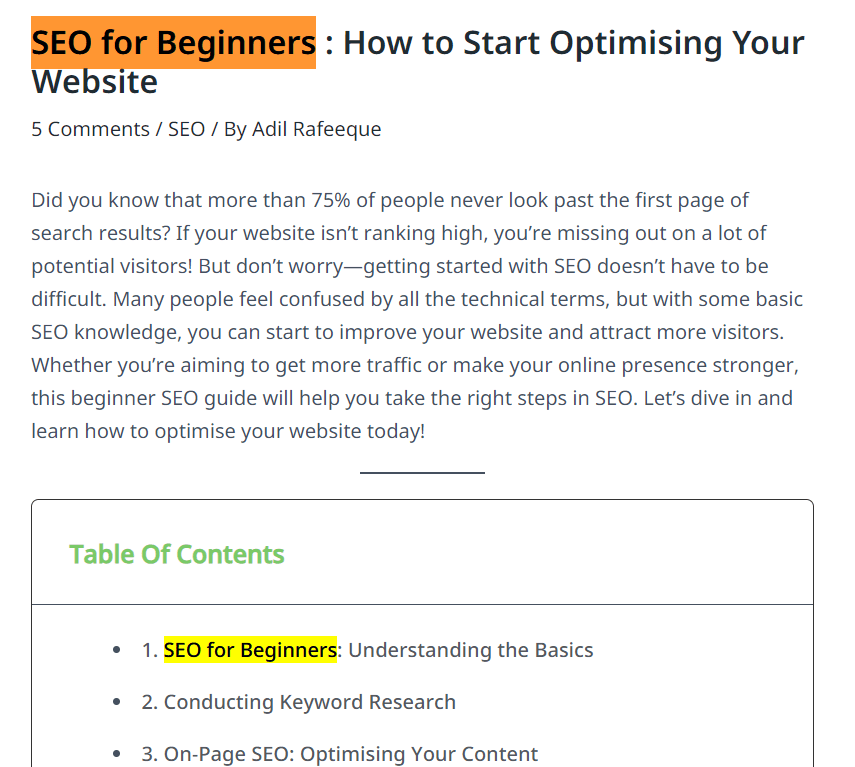Are you trying to figure out how to rank higher on search engines but feel lost in all the SEO jargon? Don’t worry—you’re not alone! On-page SEO can seem difficult at first, but once you understand the basics, it becomes much easier. In this guide, we’ll explore 15 practical on-page SEO techniques that you can start using today. These methods will help you improve your site’s visibility and rankings on Google.Digital marketing agency in kerala
Whether you’re just starting or looking to improve your skills, this guide is for you. Let’s get started!
Table Of Contents
- Understanding On-Page SEO
- Conducting Keyword Research
- Creating SEO-Friendly Titles and Meta Descriptions
- Optimising Headings and Subheadings
- Enhancing Content Quality and Relevance
- Implementing Internal Linking Strategies
- Improving Page Load Speed
- Using Alt Text for Images
- Mobile Optimization Best Practices
- Enhancing User Experience (UX)
- Frequently Asked Questions
Understanding On-Page SEO
What is On-Page SEO?
On-page SEO refers to everything you can do on your website to improve its rankings on search engines like Google. This includes optimising your content, titles, and even the structure of your website.
In simple terms: it’s what you control directly to make sure Google understands what your page is about. The better Google understands, the higher your chances of ranking well!
Key Components of On-Page Optimization
Let’s break it down. On-page SEO involves several components:
- Content Quality: Your content should be valuable and relevant to your readers.
- Keyword Placement: Use important keywords naturally throughout your content (more on that later).
- Meta Tags: These are brief descriptions of your page, which help search engines and users know what your page is about.
- Headings: Organise your content with clear headings so it’s easy to read.
- Internal Linking: This is when you link to other pages within your site to improve navigation and guide users.
Meta Tags
Meta tags are snippets of text that describe the content of a webpage. They don’t appear on the page itself but are embedded in the HTML code. The most common meta tags are:
- Title Tag: The title of a webpage, which appears in search engine results and browser tabs.
- Meta Description: A brief summary of the page content, shown in search results below the title tag. It should be engaging and include relevant keywords.
Headings
Headings are used to structure content on a webpage. They help both users and search engines understand the organisation of the content. The main types are:
- H1 (Heading 1): The main title of the page, which should include the primary keyword and be unique to each page.
- H2 (Heading 2): Subtitles or section headings under the H1. They break down the content into manageable sections.
- H3 (Heading 3): Sub-sections under H2 headings, used for further organisation within the sections.
Internal Linking
Internal linking refers to linking one page of your website to another page within the same site. This technique helps:
- Navigation: Users can easily find related content and navigate your site.
- SEO: Search engines use internal links to understand the structure of your site and distribute page authority throughout your site. For example, linking from a blog post to a related article or product page enhances the overall SEO of your site.
Conducting Keyword Research
Finding the Right Keywords
To get your page to rank well, you need to figure out what people are searching for. This process is called keyword research. Use tools like Google Keyword Planner or Ahrefs to find keywords relevant to your content.
Tip: Start with a few primary keywords and add some secondary ones to capture more traffic. These secondary keywords are often variations of the main keyword.
Here is a tutorial on how to use Google Keyword Planner.
Integrating Keywords Naturally
Once you have your keywords, use them naturally throughout your content. Avoid keyword stuffing—don’t repeat the same keyword too many times just to rank. It can hurt your rankings and make your content hard to read.
Example: If your main keyword is “on-page SEO techniques,” use it in your title, headings, and occasionally throughout the content. You can also mix it up by using related phrases like “SEO tips for better ranking.”


Creating SEO-Friendly Titles and Meta Descriptions
Writing Interesting Titles
Your title is the first thing a user (and Google) will notice. Make sure it grabs attention and includes your primary keyword. Keep it under 60 characters, so it doesn’t get cut off in search results.
Example: Instead of just “On-Page SEO Tips,” try something like “Boost Your SEO: 15 Proven On-Page Techniques for 2024.”
Optimising Meta Descriptions
Meta descriptions summarise your page in about 150-160 characters. Think of it as your page’s sales pitch. Including your primary keyword here can help increase click-through rates (CTR) when users see your page in search results.
Comments on “15 On-Page SEO Techniques to Boost Your Rankings in 2024”